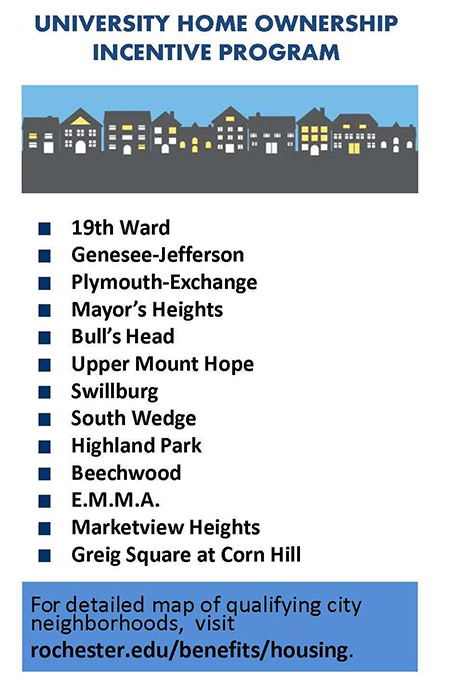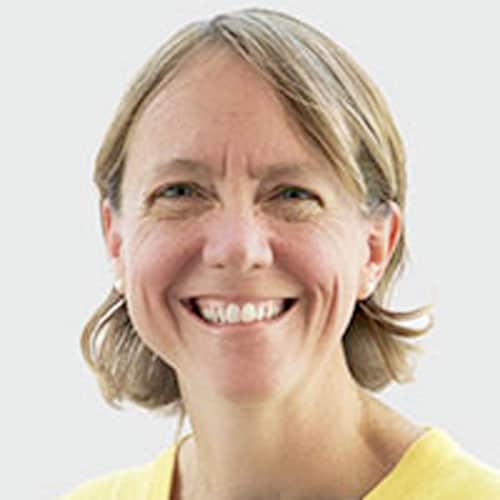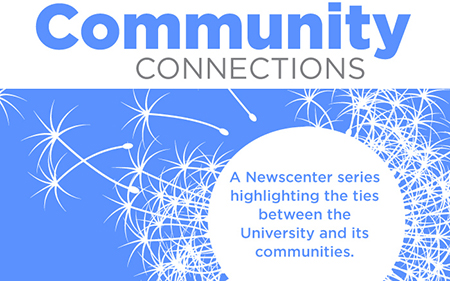A decade ago this coming March, the University launched a new home purchasing program for its employees. The University Home Ownership Incentive Program was created in collaboration with the City of Rochester, participating local lending institutions, and neighborhood partners with the dual purpose of helping employees become new homeowners by assisting with that first big down payment, and encouraging home ownership in the historic neighborhoods nearest to the University.
The program works the same way it did when it was created: the University, the City of Rochester, and one of the partner banks or credit unions each provide $3,000 toward the new mortgage of a home purchase in 13 qualifying Rochester neighborhoods. As long as the full-time or part-time University employee owns the house as their primary residence for a minimum of five years, there is no required repayment of the $9,000.
In the founding year of the initiative, two financial lenders came on board; today seven local banks and credit unions participate. In the program’s first two years, 120 employees took advantage of it. As of fall 2017, approximately 430 employees have closed on a home, and more than $1 million in financing incentives have been provided.
“The University’s Home Ownership Incentive Program has thrived and grown over the years because of its popularity with our employees, as well as the committed partners who continue to make it possible,” says Peter Robinson, vice president of government and community relations at the University. “The program has helped many University employees get into and afford a first home.”
Robinson adds that the program remains popular in part because city neighborhoods have become more popular.

“Ten years ago, the program was created as an incentive-based initiative to help enrich the city’s historic communities. Today, however, our employees need much less incentive to buy in the city because urban living has become so desirable with its many social, economic and sustainable benefits,” he says.
Erica Owens, a human resources representative at the University, purchased a historic 1890s home in the Highland Park area of the city about five years ago through the program.
“I was looking for an older house with character, which is exactly what I found,” says Owens. “Some of the features include the original wood floors, stained glass windows, tin ceiling, molding throughout, several built-ins, a large cedar closet, and an enclosed porch.”
“I also really appreciate the proximity to Highland Park, the canal path, College Town, and the South Wedge. The neighborhood offers a mix of restaurants, stores, and parks within walking distance, while maintaining a relatively quiet, residential feel and great neighbors. With my proximity to the University, I can walk or bike to work.”
The original neighborhoods in the University Home Ownership Incentive Program have remained, including Highland Park, the 19th Ward, Plymouth-Exchange, and the South Wedge. In August 2017, more regions were added— Beechwood, EMMA (East Main, Mustard & Atlantic Avenue) and Marketview Heights—to encourage even more employees to purchase homes in the city, and in areas where public transportation is abundant for ease of commuting.
“I think any program that promotes home ownership in the city should be supported,” says Dan Hurley, president of the Upper Mt. Hope Neighborhood Association. The Upper Mt. Hope residential area borders the Medical Center campus and is part of the University Home Ownership Incentive Program. “What makes the program unique is its ability to persuade employees to live close to their place of employment. This creates a stable neighborhood, reduces stress associated with transportation, and improves the carbon footprint associated with commuting. This also helps solidify the relationship between the University and neighborhoods in the city,” he adds.
NeighborWorks Rochester has been a partner from the beginning. A community-based nonprofit agency devoted to strengthening city neighborhoods, NeighborWorks provides pre-purchase education, one-on-one counseling, and post-purchase education to buyers.
“I greatly appreciated the resources made available through the University Home Ownership Incentive Program, namely the affiliation with NeighborWorks,” says Owens. “As part of the program, I attended a homebuyer/ownership class, and the instructors provided valuable insight into the buying process, which helped set the stage for a relatively stress-free experience. It all allowed me to buy sooner than I originally thought and helped me think through my budget and finances.”
For more details on Rochester’s distinct neighborhoods, visit http://celebratecityliving.com/.




